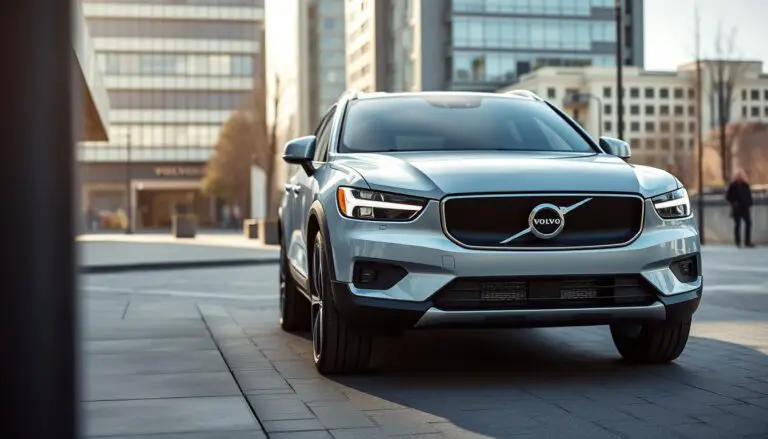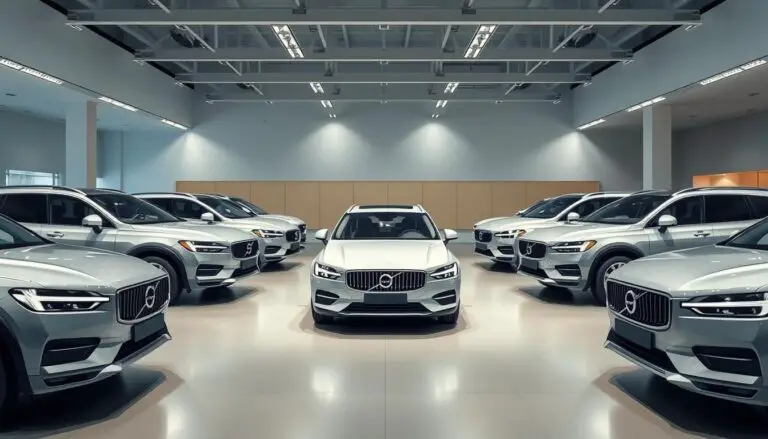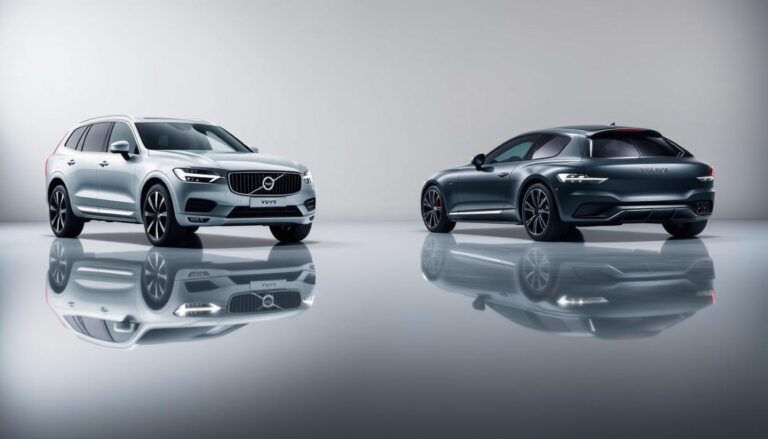When it comes to luxury cars, two brands stand out: Volvo and Lexus. Both are known for their high-quality vehicles, but they have distinct differences in their histories, design philosophies, and features.
The comparison between these two luxury car brands is crucial for potential buyers who value safety, performance, and luxury. This article will delve into the specifics of both brands, comparing their safety features, performance capabilities, interior designs, technological advancements, reliability, and pricing.
Key Takeaways
- Overview of Volvo and Lexus histories and design philosophies
- Comparison of safety features and performance capabilities
- Analysis of interior designs and technological advancements
- Reliability and pricing comparison
- Insights into which brand might be the best fit for you
The Legacy of Luxury: Brand Histories Compared
The stories of Volvo and Lexus are tales of evolution, from their humble beginnings to their current status as luxury automotive leaders. Understanding their histories provides insight into their brand identities and market approaches.
Volvo’s Scandinavian Heritage and Evolution
Volvo, founded in 1927 in Gothenburg, Sweden, is renowned for its commitment to safety and Scandinavian design. Initially manufacturing vehicles for the Swedish market, Volvo expanded globally, maintaining its focus on safety innovations. The brand is celebrated for its robust build quality and minimalist aesthetic, reflecting its Nordic heritage.
Lexus’s Japanese Precision and Market Entry
Lexus, launched in 1989 by Toyota, aimed to enter the luxury vehicle segment with a focus on high-quality craftsmanship and advanced technology. With its headquarters in Nagoya, Japan, Lexus has become synonymous with reliability and premium performance. The brand’s success is attributed to its meticulous attention to detail and commitment to delivering a superior driving experience.
| Brand | Founded | Key Characteristics |
|---|---|---|
| Volvo | 1927 | Safety innovations, Scandinavian design |
| Lexus | 1989 | High-quality craftsmanship, advanced technology |
Design Philosophy: Scandinavian Minimalism vs Japanese Elegance
In the world of luxury automobiles, the design philosophy is a key differentiator between brands like Volvo and Lexus. While both manufacturers are renowned for their high-quality vehicles, their approaches to design are distinctly shaped by their cultural and historical contexts.
Volvo’s Clean Lines and Functional Aesthetics
Volvo’s design philosophy is deeply rooted in Scandinavian minimalism, characterized by clean lines, simplicity, and a focus on functionality. This approach not only reflects the brand’s Swedish heritage but also emphasizes the importance of practicality and comfort in their vehicles. Volvo’s cars are designed to be intuitive and user-friendly, with an emphasis on ergonomic design and minimalist aesthetics. The result is a driving experience that is both serene and engaging.
Lexus’s Bold Styling and Attention to Detail
In contrast, Lexus embodies a design philosophy that blends Japanese elegance with bold styling. Lexus vehicles are known for their striking exterior designs, which often feature sharp lines and aggressive posturing. Inside, Lexus focuses on creating a premium cabin experience, with meticulous attention to detail and a commitment to using high-quality materials. This approach results in vehicles that are not only visually stunning but also offer a luxurious driving experience.
The design philosophies of Volvo and Lexus reflect their unique brand identities and cater to different tastes among luxury car buyers. While Volvo emphasizes simplicity and functionality, Lexus focuses on bold styling and luxury. Understanding these differences is crucial for potential buyers to make an informed decision that aligns with their preferences and needs.
Safety Innovations: How Volvo and Lexus Protect Their Passengers
In the realm of luxury automobiles, Volvo and Lexus stand out for their commitment to safety, incorporating advanced technologies to protect passengers. Both brands have made significant investments in safety innovations, resulting in vehicles that not only provide luxury and performance but also excel in safeguarding occupants.
Volvo’s Industry-Leading Safety Technologies
Volvo has long been recognized for its pioneering work in automotive safety. The brand’s commitment to protecting passengers is evident in its comprehensive suite of safety features.
Collision Avoidance Systems
Volvo’s collision avoidance systems are designed to prevent or mitigate the impact of a collision. These systems utilize a combination of cameras, radar, and sensors to detect potential hazards and can automatically apply the brakes if necessary. For instance, Volvo’s City Safety technology can detect pedestrians, cyclists, and other vehicles, significantly reducing the risk of accidents in urban environments.
Passive Safety Features
In addition to active safety features, Volvo also focuses on passive safety. The brand’s vehicles are designed with robust structures to absorb and distribute the forces of an impact, minimizing the risk of injury to occupants. Features such as whiplash protection systems and advanced airbag systems further enhance passenger safety.
Lexus’s Advanced Safety Systems
Lexus, too, has made significant strides in safety, with its Lexus Safety System+ being a cornerstone of its safety offerings. According to a review by Consumer Reports, Lexus’s safety features are among the most advanced in the industry.
Lexus Safety System+
Lexus Safety System+ is a comprehensive suite of safety features designed to help prevent accidents. It includes technologies such as pre-collision systems, lane departure warning, and adaptive cruise control, all working together to enhance safety on the road.
Structural Safety Design
Lexus vehicles are engineered with safety in mind, featuring high-strength materials and advanced structural designs to protect occupants in the event of a collision. The brand’s commitment to safety is reflected in its rigorous testing protocols, ensuring that vehicles meet or exceed safety standards.
Performance Metrics: Engine Options and Driving Dynamics
Both Volvo and Lexus offer a range of engine options, but their approaches to performance and driving dynamics differ significantly. This section delves into the specifics of their powertrains, handling, and ride quality to help you decide which luxury brand is right for you.
Volvo’s Powertrains and Performance Capabilities
Volvo is renowned for its emphasis on safety, but it also delivers impressive performance. The brand’s powertrains are designed to provide a balance between power and efficiency.
T5, T6, and T8 Engine Options
Volvo’s engine lineup includes the T5, T6, and T8 options. The T5 engine provides a good balance between power and fuel efficiency, while the T6 engine offers more power for those seeking enhanced performance. The T8 engine, found in Volvo’s plug-in hybrid models, combines electric power with a robust internal combustion engine for exceptional performance and efficiency.
Volvo’s vehicles are known for their agile handling and smooth ride quality. The brand’s suspension systems are tuned to provide a comfortable ride while maintaining responsive handling characteristics. This makes Volvo’s vehicles suitable for both daily driving and more spirited driving experiences.
Lexus’s Engine Lineup and Driving Experience
Lexus, Toyota’s luxury division, offers a range of engines designed to provide a blend of performance and luxury. While Lexus is often associated with comfort, its performance-oriented models deliver exciting driving dynamics.
V6, V8, and Hybrid Powertrains
Lexus’s engine options include V6 and V8 powertrains, as well as hybrid models that combine efficiency with performance. The V6 engines offer a balance between power and refinement, while the V8 engines provide more substantial power for larger models. Lexus’s hybrid powertrains deliver impressive fuel efficiency without sacrificing performance.
Ride Comfort vs Sportiness
Lexus is known for its comfortable ride quality, but the brand also offers models with more sport-oriented tuning. The F Sport models, for example, feature sport-tuned suspension and other performance enhancements to provide a more engaging driving experience. However, even in its more comfort-oriented models, Lexus maintains a focus on ride quality and refinement.
Luxury Interior: Comfort and Cabin Experience
Both Volvo and Lexus understand that a luxurious interior is crucial for a premium driving experience, incorporating advanced materials and comfort features.
Volvo’s Scandinavian-Inspired Interiors
Volvo’s interiors are renowned for their Scandinavian design philosophy, emphasizing simplicity, functionality, and high-quality materials.
Materials and Build Quality
Volvo prioritizes the use of premium materials, ensuring a tactile experience that is both luxurious and durable. The build quality is exceptional, with attention to detail evident in every aspect of the cabin.
Seating Comfort and Ergonomics
The seating in Volvo vehicles is designed with comfort and ergonomics in mind, providing supportive seating for both drivers and passengers. The ergonomic design ensures that all controls are within easy reach.
Lexus’s Premium Cabin Materials and Design
Lexus is known for its opulent interiors, featuring premium materials and meticulous craftsmanship. The design is often bold, yet elegant, creating a luxurious ambiance.
Craftsmanship and Attention to Detail
Lexus vehicles boast exceptional craftsmanship, with every detail carefully considered to enhance the driving experience. From the stitching on the seats to the dashboard trim, every element is executed with precision.
Noise Isolation and Comfort Features
Lexus places a strong emphasis on noise isolation, using advanced materials and design techniques to minimize cabin noise. Comfort features abound, including heated and cooled seats, and advanced climate control systems.
When comparing the luxury interiors of Volvo and Lexus, it’s clear that both brands excel in creating comfortable and premium cabin experiences. While Volvo focuses on Scandinavian minimalism and functionality, Lexus emphasizes bold styling and attention to detail.
Technology and Innovation: Infotainment and Connectivity
In the luxury automotive market, brands like Volvo and Lexus are pushing the boundaries of innovation. The technological features in their vehicles are a key differentiator, enhancing the driving experience through advanced infotainment systems and connectivity options.
Volvo’s Sensus System and Tech Features
Volvo’s Sensus system is renowned for its intuitive interface and comprehensive feature set. It offers a seamless driving experience with advanced connectivity and entertainment options.
User Interface and Learning Curve
The Sensus system’s user interface is designed to be user-friendly, minimizing the learning curve for drivers. Its responsive touchscreen and clear graphics make navigation straightforward.
Smartphone Integration and Connected Services
Volvo’s Sensus system supports Apple CarPlay and Android Auto, allowing for seamless smartphone integration. Additionally, it offers connected services that enhance safety and convenience, such as remote vehicle access and real-time traffic updates.
Lexus’s Infotainment Interface and Technology Offerings
Lexus’s infotainment system is designed to provide a premium driving experience with its advanced technology features. The system includes a range of innovative features that enhance both comfort and convenience.
Remote Touch Controller vs Touchscreen
Lexus employs a Remote Touch Controller in many of its models, allowing drivers to navigate the infotainment system with precision. Some models also offer touchscreen functionality, providing an alternative method of interaction. For a detailed comparison of Volvo and Lexus models, visit this page.
Audio Systems and Advanced Features
Lexus’s premium audio systems are designed to deliver exceptional sound quality, with some models featuring Mark Levinson audio systems. Advanced features such as voice recognition and navigation further enhance the driving experience.
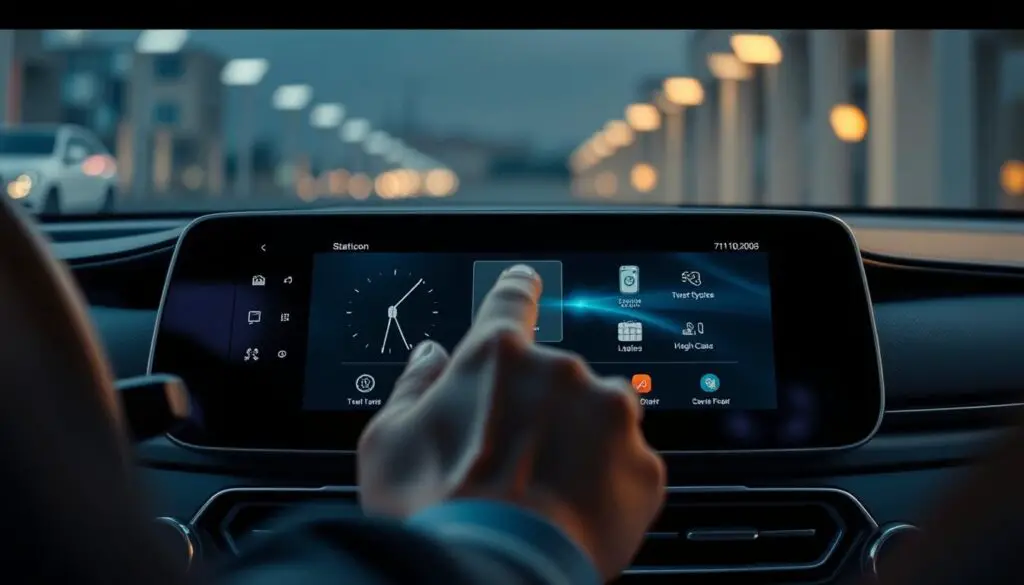
Reliability and Maintenance: Long-Term Ownership Costs
Both Volvo and Lexus pride themselves on their reliability, but how do they stack up in terms of maintenance and ownership costs? When evaluating these luxury brands, understanding their reliability ratings and maintenance requirements is crucial for making an informed decision.
Volvo’s Reliability Ratings and Maintenance Requirements
Volvo has made significant strides in reliability, with many of its models achieving high reliability ratings. According to various studies, Volvo’s newer models have shown improved reliability, with some ratings even surpassing the industry average. However, maintenance requirements can vary depending on the model and mileage. Volvo recommends regular maintenance schedules to ensure optimal performance and longevity. Owners can expect to incur standard maintenance costs, including oil changes, tire rotations, and brake pad replacements.
Lexus’s Renowned Dependability and Service Experience
Lexus is renowned for its dependability, consistently ranking high in reliability surveys. The brand’s focus on quality and durability has paid off, with many Lexus models boasting low maintenance costs and high reliability ratings. Lexus’s service experience is also noteworthy, with many owners praising the brand’s customer service and comprehensive warranty programs. While maintenance costs can vary, Lexus’s reputation for building long-lasting vehicles helps mitigate long-term ownership costs.
In conclusion, both Volvo and Lexus demonstrate strong reliability and maintenance profiles, though in different ways. Volvo has shown improvement in reliability, while Lexus continues to excel in dependability. Understanding these factors can help potential buyers assess their long-term ownership costs and make a more informed decision.
Volvo vs Lexus: Price Comparison Across Model Lines
As shoppers navigate the luxury market, understanding the pricing of Volvo and Lexus models is essential. Both brands offer a range of vehicles that cater to different needs and budgets.
The pricing strategies of Volvo and Lexus reflect their brand positioning and the value proposition they offer to customers. Volvo is known for its emphasis on safety and Scandinavian design, while Lexus is renowned for its reliability and luxury features.
Sedan Matchups: S60/S90 vs ES/LS
When comparing sedans, Volvo’s S60 and S90 models are pitted against Lexus’s ES and LS sedans. The Volvo S60 starts at around $40,000, while the S90 begins at approximately $50,000. In contrast, the Lexus ES starts at about $40,000, and the LS starts at around $76,000. The pricing indicates that both brands offer competitive options in the luxury sedan market.
Key Pricing Insights:
- Volvo S60: Starting price around $40,000
- Volvo S90: Starting price around $50,000
- Lexus ES: Starting price around $40,000
- Lexus LS: Starting price around $76,000
SUV Comparisons: XC40/XC60/XC90 vs UX/NX/RX/GX
In the SUV segment, Volvo’s XC40, XC60, and XC90 are compared to Lexus’s UX, NX, RX, and GX models. The Volvo XC40 starts at approximately $36,000, the XC60 at around $42,000, and the XC90 at about $50,000. Lexus’s UX starts at around $34,000, the NX at $35,000, the RX at $45,000, and the GX at $61,000. These prices show that both brands offer a range of SUV options at various price points.
Performance Models: Polestar vs F Sport
For performance enthusiasts, Volvo’s Polestar line and Lexus’s F Sport models offer enhanced driving experiences. The Polestar 1 starts at around $155,000, while the Polestar 2 begins at approximately $47,000. Lexus’s IS F Sport starts at around $41,000, and the GS F Sport begins at about $58,000. The RC F Sport starts at around $63,000, and the LC F Sport starts at approximately $94,000. These models cater to drivers seeking a more dynamic driving experience.
“The pricing of these performance models reflects their unique features and capabilities, offering buyers a choice between the Scandinavian flair of Polestar and the driving dynamics of Lexus’s F Sport lineup.”
Resale Value and Depreciation Factors
For luxury car owners, the initial purchase price is just the beginning; resale value and depreciation play a significant role in the overall cost of ownership. When evaluating Volvo and Lexus, it’s essential to consider how these factors impact the total cost of owning one of these luxury vehicles.
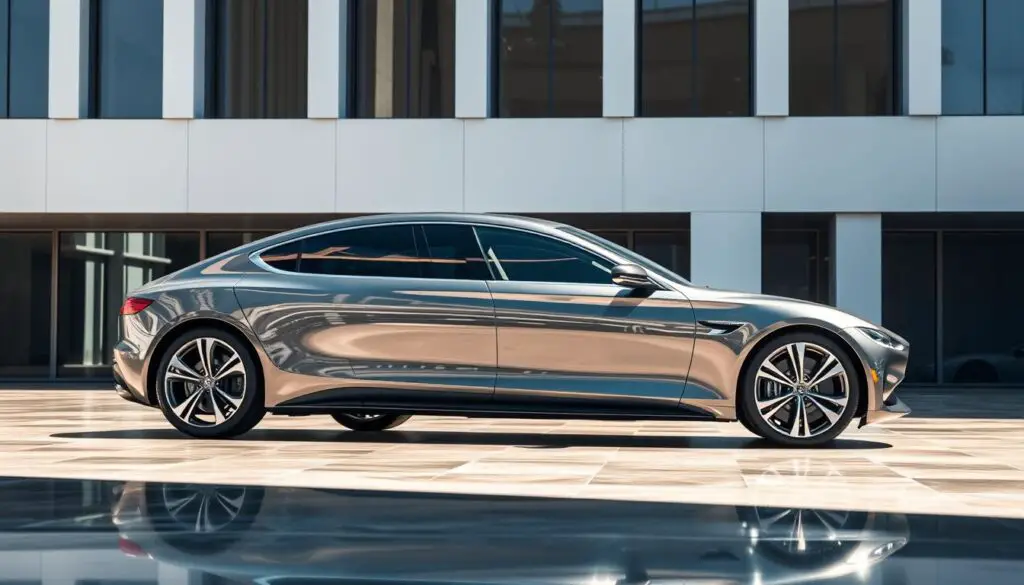
Volvo’s Depreciation Trends
Volvo vehicles are known for their strong residual values. According to data, Volvo models tend to depreciate at a slower rate compared to some of their competitors. For instance, the Volvo XC60 retains about 55% of its original price after three years. Key factors contributing to Volvo’s strong resale performance include:
- Durable construction: Volvo’s focus on building long-lasting vehicles.
- Safety features: Advanced safety technologies that are highly valued by used car buyers.
- Increasing demand: Growing popularity of Volvo’s sleek designs and eco-friendly options.
Lexus’s Strong Resale Performance
Lexus, Toyota’s luxury division, is renowned for its reliability and durability, traits that significantly enhance its resale value. Lexus models generally hold their value well, with some variants retaining up to 60% of their original MSRP after three years. The reasons behind Lexus’s strong resale performance include:
- Reliability: Lexus’s reputation for building dependable vehicles.
- Low maintenance costs: Lexus vehicles are known for requiring less maintenance over time.
- Strong brand loyalty: Lexus owners often remain loyal to the brand, driving demand for used models.
Both Volvo and Lexus offer strong resale values, but the extent of their depreciation varies based on model, condition, and market demand. Understanding these factors can help luxury car buyers make informed decisions.
Environmental Commitment: Sustainability and Electrification
Luxury car buyers are increasingly looking for brands that not only offer high performance but also prioritize sustainability, a challenge both Volvo and Lexus are rising to. As the automotive industry continues to evolve, the focus on environmental commitment is becoming more pronounced.
The shift towards sustainability involves not just the vehicles themselves but also the manufacturing processes and overall brand strategies. Both Volvo and Lexus are making significant strides in this direction, albeit with different approaches.
Volvo’s Electric Future and Climate Goals
Volvo has been a pioneer in the automotive industry’s shift towards electrification. The brand has made ambitious commitments to reduce its carbon footprint.
Recharge Lineup and Electrification Strategy
Volvo’s Recharge lineup represents the brand’s most significant step towards electrification, offering consumers a range of plug-in hybrid and fully electric vehicles. This strategy is aimed at not only reducing emissions but also providing drivers with the performance and luxury they expect from Volvo.
Carbon Neutrality Commitments
Volvo has pledged to become a carbon-neutral brand by 2040. This commitment involves not just the production of electric vehicles but also a comprehensive approach to reducing emissions across the entire value chain, from manufacturing to end-of-life vehicle disposal.
Lexus’s Hybrid Technology and Eco-Friendly Initiatives
Lexus, on the other hand, has focused on hybrid technology as its primary route to reducing environmental impact. The brand’s hybrid models have been popular among eco-conscious consumers.
Hybrid Dominance and Efficiency
Lexus’s hybrid vehicles offer a compelling blend of fuel efficiency, lower emissions, and the luxury performance expected from the brand. Models like the Lexus ES Hybrid and RX Hybrid have been particularly successful.
Future EV Plans
While Lexus has been predominantly hybrid-focused, the brand has announced plans to expand its electric vehicle offerings in the coming years. This move is part of Lexus’s broader strategy to enhance its sustainability credentials and appeal to a wider range of environmentally conscious buyers.
Both Volvo and Lexus are committed to reducing their environmental footprint, though their strategies differ. Volvo is aggressively pushing towards full electrification, while Lexus is leveraging its hybrid technology expertise. The table below summarizes their key environmental commitments.
| Brand | Electrification Strategy | Carbon Neutrality Goal |
|---|---|---|
| Volvo | Full electrification by 2030 for some models, with a Recharge lineup | Carbon neutral by 2040 |
| Lexus | Hybrid dominance with plans for expanded EV offerings | Reducing CO2 emissions across the model lineup |
Real-World Driving Impressions
The driving impressions of Volvo and Lexus reveal distinct characteristics that set these luxury brands apart in terms of handling and overall driving dynamics. Both brands have their unique strengths that cater to different driving preferences.
Volvo’s Driving Character
Volvo’s vehicles are known for their responsive handling and precise steering. The Scandinavian brand has mastered the art of creating cars that are both safe and enjoyable to drive. For instance, the Volvo S60 offers a comfortable ride coupled with agile handling, making it a joy on both straight highways and winding roads.
Lexus’s On-Road Experience
Lexus, on the other hand, is renowned for its luxurious and refined driving experience. Models like the Lexus ES provide a silent ride and effortless acceleration. The brand’s focus on comfort and quietness makes its vehicles ideal for those who prioritize a serene driving environment.
| Feature | Volvo | Lexus |
|---|---|---|
| Handling | Responsive and precise | Smooth and comfortable |
| Ride Comfort | Comfortable ride with agile handling | Silent and effortless |
Conclusion: Making Your Luxury Choice
Choosing between Volvo and Lexus ultimately depends on your personal preferences and priorities. Both luxury brands offer exceptional vehicles with unique strengths. Volvo is renowned for its safety innovations, Scandinavian design, and commitment to sustainability.
Lexus, on the other hand, is celebrated for its premium quality, advanced technology, and driving dynamics. When making your luxury choice, consider factors such as design, safety features, performance capabilities, and price.
In the Volvo vs Lexus comparison, it’s clear that both brands cater to different needs. Volvo’s emphasis on safety and eco-friendliness appeals to those seeking a responsible luxury experience. Lexus’s focus on premium materials and driving pleasure attracts those who value comfort and performance.
Ultimately, the decision between Volvo and Lexus comes down to your individual needs and what you value most in a luxury vehicle. By weighing the key differences and similarities between these two esteemed brands, you can make an informed decision that suits your lifestyle and preferences.
FAQ
What are the main differences between Volvo and Lexus?
Volvo is known for its Scandinavian design and emphasis on safety, while Lexus is recognized for its Japanese precision and luxury features.
How do Volvo and Lexus compare in terms of safety features?
Both Volvo and Lexus offer advanced safety features, including collision avoidance systems and passive safety features, but Volvo is often considered to have a more comprehensive safety package.
What are the engine options available for Volvo and Lexus models?
Volvo offers a range of engine options, including T5, T6, and T8 engines, while Lexus provides V6, V8, and hybrid powertrains.
How do the interiors of Volvo and Lexus compare in terms of luxury and comfort?
Both brands offer premium interiors, but Volvo is known for its Scandinavian-inspired minimalism, while Lexus is recognized for its attention to detail and craftsmanship.
What are the pricing strategies for Volvo and Lexus across their model lines?
Volvo and Lexus have different pricing strategies, with Volvo often positioned as a more premium brand, while Lexus offers a range of models at various price points.
How do Volvo and Lexus compare in terms of reliability and maintenance costs?
Both brands have a reputation for reliability, but Lexus is often considered to have a stronger track record, with lower maintenance costs over time.
What are the environmental commitments of Volvo and Lexus?
Volvo has made a commitment to become carbon neutral by 2040, while Lexus is focusing on hybrid technology and eco-friendly initiatives.
How do Volvo and Lexus compare in terms of resale value and depreciation?
Lexus is known for its strong resale performance, while Volvo’s depreciation rates can be higher, depending on the model and trim level.
What are the key differences between Volvo’s Sensus system and Lexus’s infotainment interface?
Volvo’s Sensus system is known for its user-friendly interface, while Lexus’s infotainment system is often controlled through a remote touch controller.
How do Volvo and Lexus compare in terms of performance and driving dynamics?
Volvo is known for its responsive handling, while Lexus is often praised for its ride comfort and refinement.

